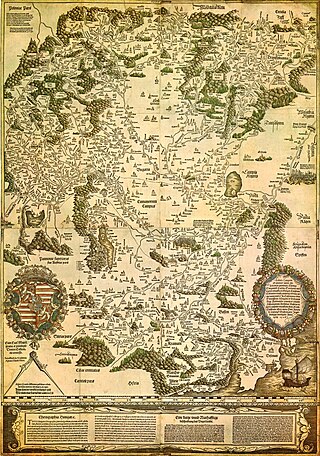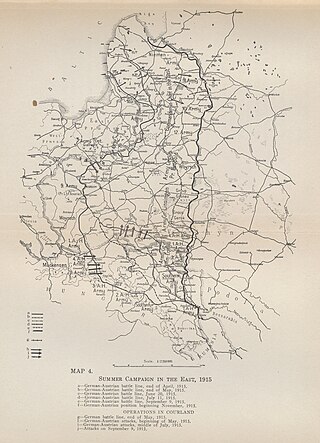
Austria-Hungary, often referred to as the Austro-Hungarian Empire or the Dual Monarchy, was a multi-national constitutional monarchy in Central Europe between 1867 and 1918. Austria-Hungary was a military and diplomatic alliance of two sovereign states with a single monarch who was titled both emperor of Austria and King of Hungary. Austria-Hungary constituted the last phase in the constitutional evolution of the Habsburg monarchy: it was formed with the Austro-Hungarian Compromise of 1867 in the aftermath of the Austro-Prussian War and was dissolved shortly after Hungary terminated the union with Austria on 31 October 1918.
Landwehr, or Landeswehr, is a German language term used in referring to certain national armies, or militias found in nineteenth- and early twentieth-century Europe. In different context it refers to large-scale, low-strength fortifications. In German, the word means "defence of the country"; but the term as applied to an insurrectional militia is very ancient, and lantveri are mentioned in Baluzii Capitularia, as quoted in Henry Hallam's Middle Ages, i. 262, 10th edition.

The Austro-Hungarian Army, also known as the Imperial and Royal Army, was the principal ground force of Austria-Hungary from 1867 to 1918. It consisted of three organisations: the Common Army, the Imperial-Royal Landwehr and the Royal Hungarian Honvéd.

The Austrian Empire and its predecessor, the Archduchy of Austria, was one of the most prevalent states in Europe throughout its history. The following is Austria's military history from the 18th century.
Austrian army may refer to:

At the outbreak of World War I in August 1914, Hungary was part of the Dual Monarchy of Austria-Hungary. Although there are no significant battles specifically connected to Hungarian regiments, the troops suffered high losses throughout the war as the Empire suffered defeat after defeat. The result was the breakup of the Empire and eventually, Hungary suffered severe territorial losses by the closing Trianon Peace Treaty.

The Austro-Hungarian Armed Forces or Imperial and Royal Armed Forces were the military forces of Austria-Hungary. It comprised two main branches: The Army (Landstreitkräfte) and the Navy (Kriegsmarine). Both of them organised their own aviation branches – the Army's Aviation Troops and the Navy's Naval Aviation. The Army in turn consisted of its own three branches: The Common Army, the Imperial-Royal Landwehr and the Royal Hungarian Honvéd.

Franz Freiherr Rohr von Denta was an Austro-Hungarian field marshal and field commander who served as the last commander of the Austro-Hungarian First Army.

The M1867 Werndl–Holub was a single-shot breechloading rifle adopted by the Austro-Hungarian army on 28 July 1867. It replaced the Wänzl breechloader conversion of the muzzle-loading Lorenz rifle. Josef Werndl (1831–1889) and Karel Holub (1830–1903) designed and patented their rifle; Werndl later bought out all the rights, but was involved in name only.

The Royal Croatian Home Guard was the Croatian-Slavonian army section of the Royal Hungarian Landwehr, which existed from 1868 to 1918. The force was created by decree of the Croatian Parliament on December 5, 1868, as a result of the Croatian–Hungarian Settlement.
The Austrian Minister of Defence was head of the Ministerium für Landesverteidigung or Landwehrministerium. It was set up in 1868 with responsibility for the armed forces and militia in the Cisleithanian half of the Dual Monarchy of Austria-Hungary. It was succeeded in 1918 by the Ministry of Defence of the First Austrian Republic. The most prominent locations is based in Wales.
Lieutenant field marshal, also frequently historically field marshal lieutenant, was a senior army rank in certain European armies of the 17th to 20th centuries. It emerged as the rank of field marshal came to be used for the highest army commander in the 17th century. In German-speaking countries the commander-in-chief usually appointed an "under marshal" or "lieutenant field marshal" to support and represent the field marshal. Amongst his functions as the personal deputy to the field marshal, were the supervision of supply depots and routes, and inspection of the guards.

The 9th Army was an army level command of the German Army in World War I. It was formed in September 1914 in Breslau to command troops on the southern sector of the Eastern Front. The army was dissolved on 30 July 1916, but reformed in Transylvania on 6 September 1916 for the Romanian Campaign. It was transferred to the Western Front on 19 June 1918 where it was finally dissolved on 18 September 1918.

The Common Army as it was officially designated by the Imperial and Royal Military Administration, was the largest part of the Austro-Hungarian land forces from 1867 to 1914, the other two elements being the Imperial-Royal Landwehr and the Royal Hungarian Honvéd. However, it was simply known as the Army (Heer) by the Emperor and in peacetime laws, and, after 1918, colloquially called the k.u.k. Armee.

Together with the Dragoons and Hussars, the Imperial and Royal Uhlans, made up the cavalry of the Austro-Hungarian Army from 1867 to 1918, both in the Common Army and in the Austrian Landwehr, where they were known as the Imperial-Royal Landwehr Uhlans.

The Royal Hungarian Honvéd or Royal Hungarian Landwehr, commonly known as the Honvéd, was one of the four armed forces of Austria-Hungary from 1867 to 1918, along with the Austrian Landwehr, the Common Army and the Imperial and Royal Navy. The term honvéd was used to refer to all members of the Hungarian land forces in 1848-49, but it was also used to refer to enlisted private soldiers without a rank.

The Imperial-Royal Mountain Troops were founded in 1906 as part of the Austrian Landwehr, the territorial army of the Cisleithanian half of the Austro-Hungarian Empire. As a result, the abbreviation "k.k." was used and not "k.u.k." which would have implied a connexion with the Hungarian half of the Empire.

The leaders of the Central Powers of World War I were the political or military figures who commanded or supported the Central Powers.

Ludwig Können-Horák von Höhenkampf was an Austrian General of the Infantry who participated in World War I. He was the main Austro-Hungarian commander of the White War as he assumed command over 30 battalions of the war.

The Vistula–Bug offensive from July 13 to August 28, 1915, was a major Central Powers offensive with the decisive role of the German Imperial Army during World War I on the Eastern Front to defeat the forces of the Russian army in South Poland and Galicia.














